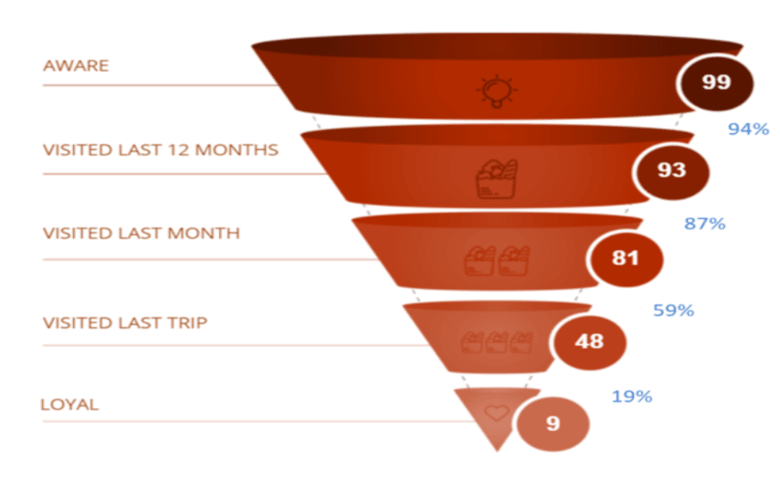A conversion rate is the percentage of people or companies that move from one stage to the next stage in a process. Common examples include the proportion of people who go to a web page and go on to sign up, and the proportion of people who trial a product and end up purchasing.
The term has been borrowed from the idea of conversion in religion. In sales and marketing, the main goals of measuring conversion rates are to identify weak spots in a company’s customer acquisition process. This is also known as conversion optimization. It is also used as a metric for comparing the performance of differing marketing initiatives. Various frameworks are used when examining conversion rates. The can include digital marketing funnels, sales funnels, brand health, and the hierarchy of effects.
Example
Consider the brand health data for a grocery store, shown below. The conversion rate from awareness to visited in the last 12 months is 94% (93/99). For visited last month relative to visited in last 12 months is 87% (81/93), and so on. The big weak spot evident in this conversion rate analysis is that customer loyalty is a problem, with only 19% of those who visited being loyal (presumably they visited due to convenience or a price discount of some kind).

You can identify weaknesses in conversion by comparing conversion rates over time, between key subgroups, and by-products. You can also use them to understand the effectiveness of different initiatives. For example, it is common to use conversion rates when evaluating performance in A/B testing (e.g., comparing two different page designs, and seeing which results in the better conversion rate).
Sales conversion rates
In sales, conversion rates measure how effectively potential customers move through different stages before making a purchase. These stages typically include cold prospects, warm prospects, marketing-qualified leads (who have shown a certain level of interest), sales-qualified leads (who have been identified as promising opportunities), trialists, and finally, customers. The specific stages vary depending on the business model and sales strategy.
Only after establishing these clear stages in the process can businesses start to improve their sales conversion rates. Strategies include refining lead qualification criteria, nurturing prospects with relevant content, leveraging automation to follow up efficiently, and addressing objections early in the sales cycle. Data-driven insights can also help identify bottlenecks and areas for improvement, ensuring a smoother path from initial interest to final purchase.
Other conversion rate frameworks
Many frameworks are widely used when analyzing conversion rates. In digital marketing, there are many variants of a funnel (which is a diagram like the one above). They show different stages of the acquisition process, such as: impressions (e.g., by ads, social media), visiting the home page, searching, adding a product to a basket, going to checkout, purchasing, and regularly purchasing.
In retailing, funnels are also used but tend to be called brand health metrics. They show various movements from awareness through to loyalty, as in the example above. If you would like to create a brand funnel, we've created a handy guide for you.
In markets with heavy amounts of brand advertising, the hierarchy of effects model is also common, tracking conversion through the stages of awareness, knowledge, consideration, preference, purchase, and recommendation.
Ready to discover more about market research terms? Check out the market research section of our blog!



